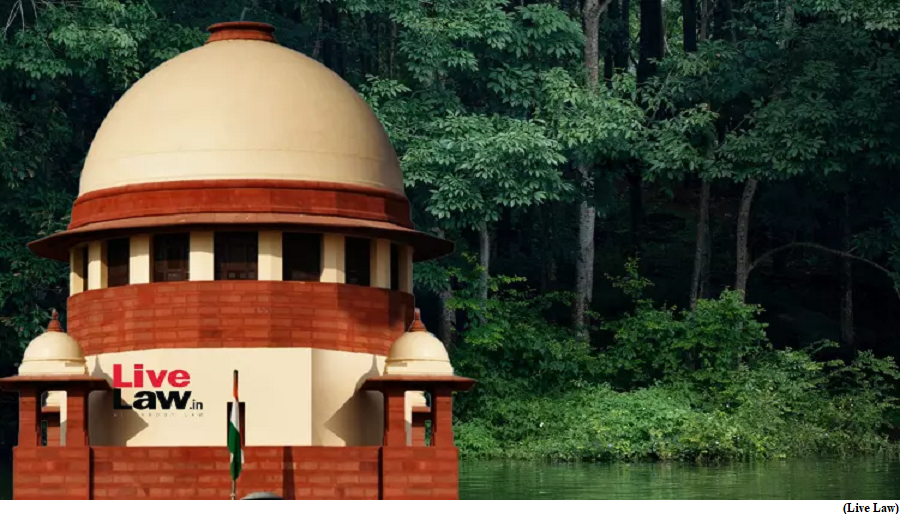SC directs govts to follow ‘broad’ definiton of forests (GS Paper 3, Environment)

Why in news?
- The Supreme Court has directed governments to follow the “broad and all-encompassing” definition of forest as laid down in its 1996 judgment in the T N Godavarman case until a consolidated record of all kinds of forests across the country is prepared.
- A three-judge Bench led by Chief Justice of India (CJI) D Y Chandrachud passed the order on petitions that challenged the 2023 amendments to the Forest (Conservation) Act, 1980 (FCA) on the ground that the modifications had “substantially diluted” the definition of forest, and had reduced the ambit of the Act.

Why was the Forest (Conservation) Act amended in 2023?
- In the Statement of Objects and Reasons for the Forest (Conservation) Amendment Bill, 2023, passed by both Houses in July-August 2023, the government said that applicability of the FCA had been widened by the judgment of the Supreme Court in T N Godavarman Thirumalpad v. Union of India (December 12, 1996).
- “Subsequent to the said Judgment, the provisions of the Act were applied in… recorded forests which had already been put to various type of non-forestry use, thereby restraining the authorities from undertaking any change in the land use and allowing any development or utility related work,” the Statement of Objects and Reasons said.
- As a remedy, the amendment made the FCA applicable only to notified forests and lands that were identified as ‘forest’ in government records.
How exactly did the Supreme Court define ‘forest’ for the purposes of the Act?
- The court ruled that the FCA would apply to all land parcels that were either recorded as ‘forest’, or which resembled the dictionary meaning of forest.
- The 1996 judgment said: “The word ‘forest’ must be understood according to its dictionary meaning. This description covers all statutorily recognised forests, whether designated as reserved, protected or otherwise… The term ‘forest land’ will not only include ‘forests’ as understood in the dictionary sense, but also any area recorded as forest in the Government record irrespective of the ownership.”
- The CJI-led three-judge Bench reaffirmed this principle, saying that the dictionary meaning of forests had been adopted by the court to align with Parliament’s intent behind legislating the FCA in 1980.
To what extent did the SC’s 1996 judgment really expand the ambit of the FCA, 1980?
- The declared intent of the 2023 amendment was to correct the situation arising out of the perceived expansion of the FCA’s applicability by the SC.
- However, under sub-sections ii, iii, and iv of Section 2 (“Restriction on the dereservation of forests or use of forest land for non-forest purpose”) of the FCA, the ambit of the law is not limited to only “reserved forest”, it bars the unauthorised non-forest use of any forest land.
- In the FCA, the term “reserved forest” is used only in the limited context of dereservation. Section 2(i) says that no reserve forest “shall cease to be reserved” without prior approval from the Centre. Clearly, a clause on dereservation can only apply to what is reserved.
- This principle was reiterated by the Supreme Court in July 2022 in Narinder Singh & Ors vs Divesh Bhutani & Ors. “As clause (i) specifically refers to a reserved forest…it is obvious that clauses (ii), (iii) & (iv) apply to any other forest… Therefore, forest as understood by its dictionary meaning is covered by Section 2” of the FC Act itself.
What about the argument that following the T N Godavarman judgment, the FCA was impeding the government’s welfare agenda?
- The government had justified the 2023 amendments as a means to address the development needs of forest-dwelling tribes.
- However, the basic development needs of tribal communities are covered under Section 3 of the Forest Rights Act, 2006, that requires the Centre to divert forest land “notwithstanding anything contained in the FC Act” for certain facilities managed by the government.
- An amendment to the FCA would not have been necessary only to build these facilities such as schools, dispensaries/hospitals, anganwadis, ration shops, power/phone lines, tanks, water pipelines, minor irrigation canals, vocational training centres, roads, community centres, etc.
Who challenged the 2023 amendments to the law, and on what grounds?
- The challenge (Ashok Kumar Sharma, IFS (Retd) & Ors v. Union of India & Ors) was filed by a group of retired Indian Forest Service officers and NGOs such as Vanashakti and Goa Foundation.
- The petitions echoed some of the concerns raised by the dissenting members of the Joint Parliamentary Committee (JPC) that had examined the amendments. The major apprehension was the potential exclusion of 28% of India’s forests that lie outside Recorded Forest Areas from the purview of the FC Act.
- The petitioners argued that pending finalisation of the consolidated record of forests — required to be completed within one year under the amended 2023 Rules — land parcels that would have been considered forests under the 1996 judgment could now be used for non-forest purposes without requiring any clearance under the FCA.
- At this, the SC explicitly asked its 1996 definition to be followed until the consolidated record of forests was finalised.
What happens now?
- The Supreme Court said that while the expert committees set up under the 2023 Rules should take into account the progress made by the previous expert panels, they are free to expand the protection umbrella to any forest land that is worth protecting.
- The matter will be heard for final disposal in July.
African Union imposes historic ban on cruel donkey skin trade
(GS Paper 2, International Relation)
Why in news?
- A historic ban on the trade in donkey skin has been agreed upon by the African heads of state. This agreement, announced on the concluding day of the African Union summit in Ethiopia, outlawed killing of donkeys in the African continent for their skin.
- This is a significant outcome following the Dar es Salaam declaration adopted at the first AU-IBAR Pan-African Donkey Conference in December 2022.

Details:
- The statement acknowledged the socioeconomic significance of donkeys in Africa. It had demanded for an African Union Commission (AUC) resolution to be passed in favour of a 15-year ban on the commercial killing of donkeys for their skin.
- Other demands included the creation of an Africa donkey strategy for donkey production and productivity, and the inclusion of donkeys in the global development agenda.
Why donkey skin is traded?
- Donkey skin is used to make the traditional Chinese medicine ejiao. It is in constant demand, fueling a global trade that is vicious, unsustainable and opportunistic.
- In five years between 2016 and 2021, ejiao production is estimated to have increased by 160 per cent.
- The ejiao industry now requires a minimum of 5.9 million donkey skin annually to keep up with the latest Chinese demand, the organisation noted.
- The demand for donkey skin reduced the donkey population in China from 11 million in 1992 to just under two million. Efforts to intensively farm donkeys locally failed to address this demand.
- So, the demand for ejiao, a gelatine manufactured by boiling donkey skin, is met primarily by imported skin sourced from South America and Africa.
- With increasing demand, at least 6.8 million donkeys are projected to be killed every year in 2027.
Donkey in Africa:
- Africa is particularly affected by this, as it is home to over two-thirds of the 53 million donkeys estimated to exist worldwide. Farmers who depend on donkeys for their livelihoods have seen theft and cruel treatment of animals as a result of the increased demand.
- The countries where donkeys are being traded illegally for their skin include Ghana, Nigeria, Botswana, Burkina Faso, Mali, Niger, Senegal, Uganda, Ethiopia, South Sudan, Tanzania, Kenya and Egypt.
- The number of donkeys in Africa has decreased dramatically over the past 10 years.
New agreement:
- The historic pan-African agreement will protect 33 million donkeys that are on the continent from being stolen, trafficked and killed. This will also save tens of thousands of African communities who depend on donkeys for their well-being and means of subsistence.
- Donkeys are critical to millions of people and the global trade in donkey skin undermines efforts to achieve at least nine of the 17 United Nations-mandated sustainable development goals. These include the goal to end poverty (SDG1), since equid ownership represents the only viable escape from extreme poverty.
- For example, two-thirds of donkey owners in Mali reported a monthly income of more than $167, through the work of their donkeys, above the average per capita income. For rural households in Ethiopia, working equids contribute an average of 14 per cent of family income.
Way Forward:
- Brazil is also likely to impose a ban on illegal donkey skin trade. This may disrupt the supply chain and the ejiao industry in China.




